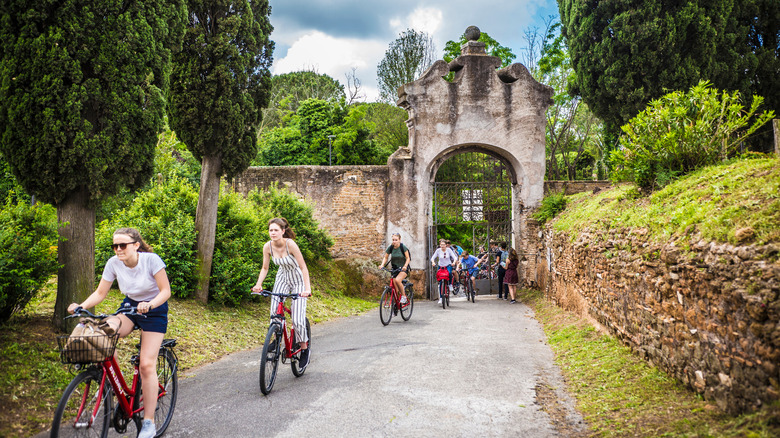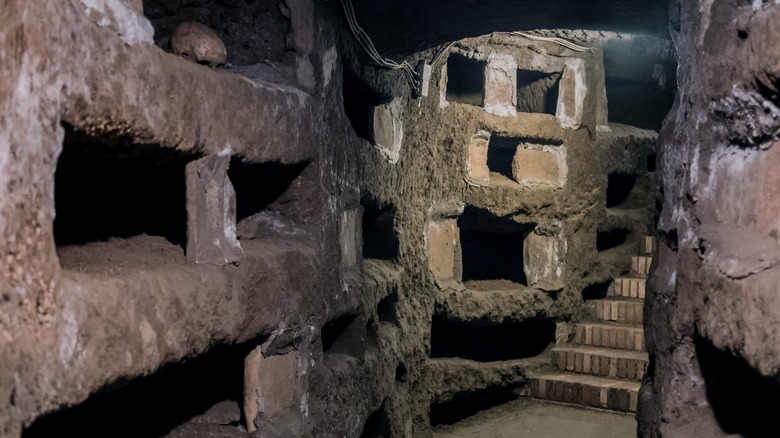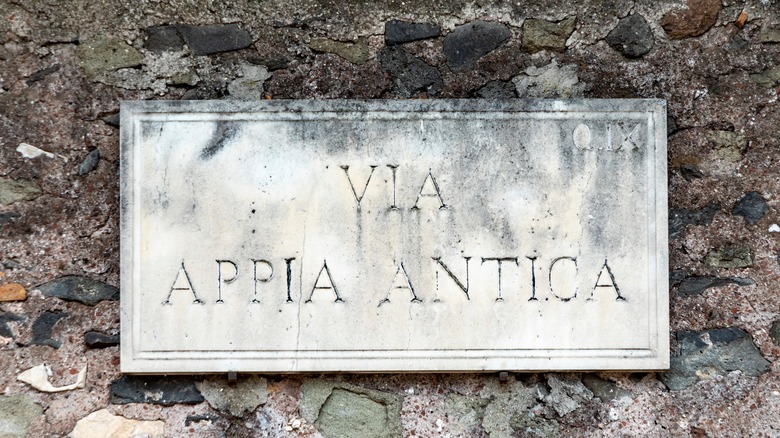Rick Steves Says To Avoid This Dangerous And Overcrowded Stretch Of Rome's Catacombs
Rome, the indisputable "Eternal City," continues to entertain and awe visitors millennia later. Today, tens of millions of people visit the city center to see some of the planet's finest ruins, still standing strong above ground. However, like many of Rome's best-kept secrets, one must search deeper than what can be seen on the surface. An incredible attraction awaits those seeking such an experience, especially if travelers are willing to venture through Rome's morbid and heavenly realm of catacombs.
For the brave enough, Rick Steves advises avoiding a particularly dangerous stretch between the San Sebastiano and San Callisto Catacombs, known as "Via Appia Antica" or the Appian Way. Named after Emperor Appius Claudius Caecus, this ancient roadway was built in 312 B.C. It marked the creation of Rome's first express highway, as it mostly ran in a straight line instead of following the natural landscape. It connects the city to Capua and later to Brindisi, spanning 430 miles.
Like most Roman engineering, the Appian Way quickly became a success, bridging Rome economically and militarily with Greece and the rest of the Eastern world. This construction still remains, attracting many travelers to walk along the same stone road that Romans once did. But, upon exiting the San Sebastiano Catacombs, you find yourself on a high-traffic thoroughfare of the Appian Way, without a sidewalk, crowded by vehicles. Rick Steve notes that you shouldn't worry; you're not missing much, as this stretch of the famous Appian Way is the least interesting anyway.
The Appian Way and Rome's catacombs
It might seem odd that catacombs would be lined along the Appian Way, but they were absolutely necessary. Unfortunately for anybody planning a burial (or cremation), it was forbidden to bury within Rome's city walls from as early as the fifth century B.C. Historians speculate that this is likely due to several factors: first, the limited size of Rome; second, the designation of consecrated land; and third, the religious standards and practices of the time. A burial would render an area a religious site that could not be altered. Hence, the creation of the catacombs of San Sebastiano and San Callisto — some of the best sites ancient history lovers could visit on their trip to Rome.
For those unfamiliar with catacombs, they are underground necropoleis. Although it may seem like excavating an entire complex for the dead would be difficult, Italy's native tufa (volcanic rock) made it easier to shape than other types of underground compositions. Within the San Sebastiano Catacomb, which stretches for 7.5 miles, you will see its namesake and Christian martyr, Saint Sebastian, as well as the sarcophagi, tombs, and frescos with various religious significance. The same goes for the 12-mile and four-level San Callisto Catacomb, the official cemetery of the church in the third century. Here, half a million Christians were buried, including 16 popes — giving the burial area a fitting nickname, "The Little Vatican."
Tips for your visit
Before visiting Rome's catacombs beneath the Appian Way, you should know a few basic rules. Unfortunately, they are not wheelchair accessible, limiting access to anybody needing mobility aid. Second, the catacombs are about 65 feet underground with an average temperature of around 60 degrees Fahrenheit, so dress appropriately. Make sure to bring a scarf or a shawl for modesty, as it is considered a religious site.
To avoid this dangerous and crowded stretch of the Appian Way, Rick Steves advises taking the pedestrian and bike path that begins about 100 feet north of the Catacombs of San Sebastiano at the intersection with Via delle Sette Chiese. He suggests going through the arch at #126 to reach a quiet road that runs parallel to the Appian Way and will also lead you to the Catacombs of San Callisto. Steves notes that the gate can be closed on Wednesdays, so visitors will have no choice but to stay on the Via Appia Antica. Be cautious of traffic — on days like this, it can be particularly busy. Vehicle's mirrors can get quite close, so stay tight to the shoulder.
You can reach the Catacombs and Appian Way by taxi, metro, bus, or foot. However, Rick Steves recommends visiting on a Sunday or a holiday, as the area is at least closed to car traffic. Moreover, if you really want to avoid crowds during your trip to Italy, it's best to travel between April and June or September and October.


